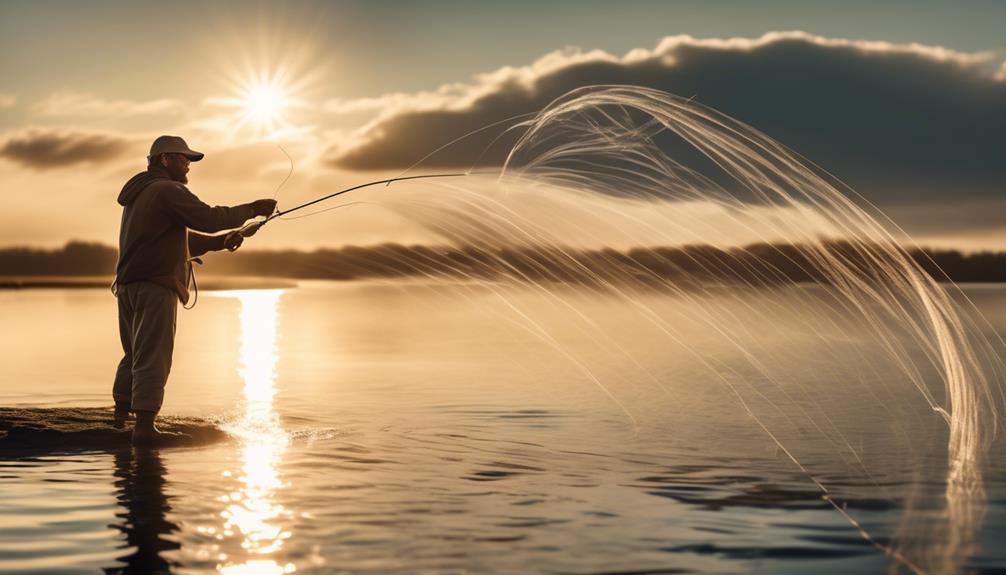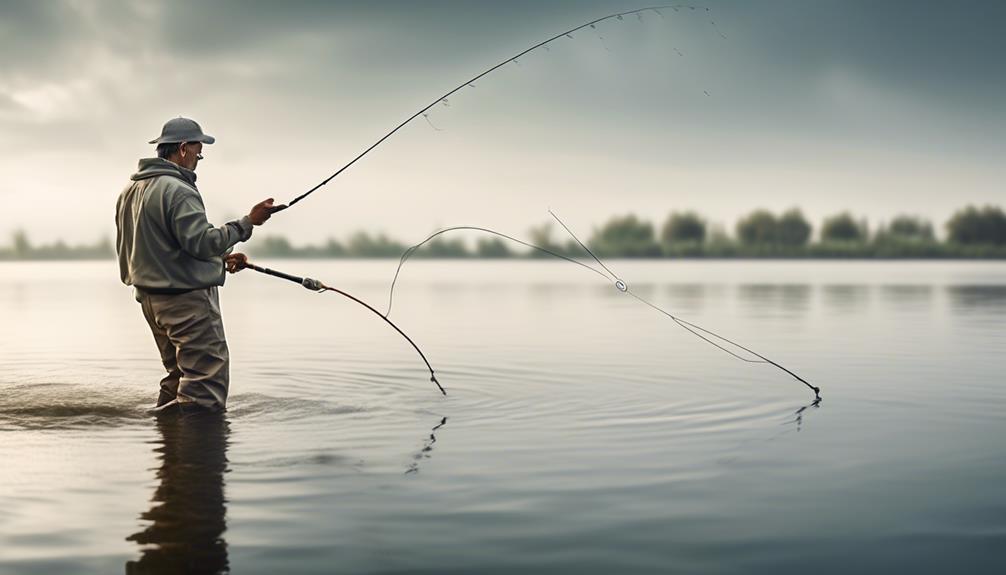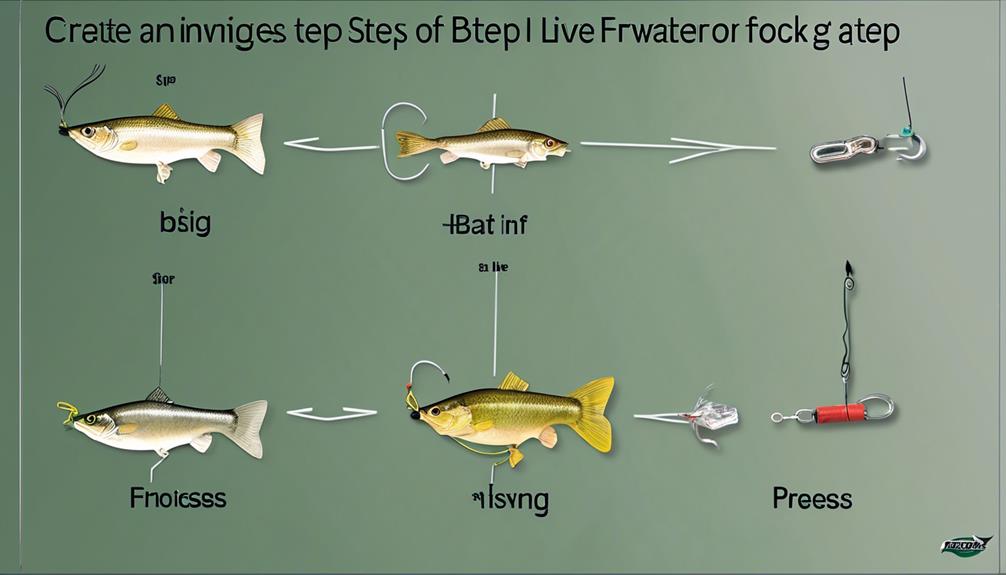Are you aware that choosing the right fishing line can increase your chances of catching a trophy fish by up to 30%? It's a significant factor that often gets overlooked, but the type of line you use can make all the difference in your freshwater fishing success.
Whether you're a novice or an experienced angler, understanding the nuances of different fishing lines can be the key to reeling in the big one. So, which lines are the best for successful freshwater fishing?
Let's explore the top 8 lines that can elevate your game and help you land that prized catch.
Monofilament Line

When freshwater fishing, always remember to spool your reel with high-quality monofilament line to ensure strength and durability. Line strength is crucial in freshwater fishing as it determines the ability to handle the weight and resistance of the fish.
Opt for monofilament lines with a higher pound test, as they offer better resistance to abrasion and can handle the weight of larger fish species commonly found in freshwater bodies. Consider using knot tying techniques like the Palomar knot or the improved clinch knot to ensure that the line is securely attached to the hook or lure, minimizing the risk of breakage when reeling in a catch. These knots are known for their reliability and can significantly enhance the overall strength of the line, providing you with the confidence to tackle formidable opponents in the water.
When selecting monofilament line for freshwater fishing, prioritize features such as abrasion resistance, shock strength, and knot security. These qualities are essential for handling the diverse conditions and challenges present in freshwater environments.
Additionally, be sure to inspect the line regularly for any signs of wear and tear, and re-spool as needed to maintain its strength and integrity. By paying attention to the quality of your monofilament line and mastering effective knot tying techniques, you can elevate your freshwater fishing experience and increase your chances of landing that prized catch.
Fluorocarbon Line
As you explore alternative options for your fishing line, consider the advantages of using fluorocarbon line to enhance your freshwater fishing experience.
Fluorocarbon line has several distinct advantages that make it a popular choice among anglers. Firstly, fluorocarbon line is virtually invisible underwater due to its refractive index, making it ideal for clear water conditions and wary fish. This feature can significantly increase your chances of getting more bites.
Additionally, fluorocarbon line has low stretch, providing excellent sensitivity and allowing you to detect subtle strikes more effectively than with monofilament line. Its abrasion resistance is another key advantage, enabling you to fish near rocks, wood, and other underwater structures without worrying about line breakage.
However, it's important to be aware of some drawbacks when using fluorocarbon line. One of the main issues is its tendency to be stiffer than monofilament, which can affect casting distance and manageability, especially in lighter pound tests. To mitigate this, it's crucial to choose the appropriate fluorocarbon line for your specific fishing needs. Another consideration is the higher cost of fluorocarbon compared to monofilament.
When using fluorocarbon line, it's essential to spool it carefully onto your reel to prevent line twists and tangles. Additionally, tying fluorocarbon knots correctly is crucial to avoid weakening the line. It's recommended to use clench or improved clinch knots, as they're reliable and retain much of the line's original strength.
Lastly, regularly inspect your fluorocarbon line for any signs of wear or damage, as it can degrade over time due to UV exposure and use. Following these best practices will help you maximize the advantages of fluorocarbon line while minimizing its drawbacks during your freshwater fishing endeavors.
Braided Line
Consider utilizing braided line for its exceptional strength and minimal stretch, ideal for targeting freshwater game fish in various conditions. When it comes to knot tying, braided lines can be a bit trickier compared to monofilament or fluorocarbon lines. Due to its smaller diameter and slickness, it's important to use appropriate knots that are well-suited for braided line, such as the Palomar knot or the improved clinch knot. These knots are strong and reliable, ensuring that your line holds up against the strength of the fish you're targeting.
Braided lines are known for their superior line strength, making them perfect for hauling in larger freshwater species like pike, muskie, or catfish. The thin diameter of braided line allows for increased line capacity on your reel, giving you the ability to handle powerful runs and sudden bursts of energy from your catch. Additionally, the minimal stretch of braided line provides enhanced sensitivity, allowing you to feel even the slightest nibbles and movements underwater.
When using braided line, it's important to match it with the right rod and reel setup to fully maximize its benefits. A medium to heavy power rod with a fast action tip is recommended, paired with a high-quality spinning or baitcasting reel specifically designed to handle braided line. By taking these factors into consideration, you can confidently tackle freshwater fishing with braided line, knowing that you have the strength and control needed to reel in those elusive trophy fish.
Copolymer Line
For optimal performance in freshwater fishing, incorporating copolymer line into your setup can provide the versatility and strength needed to tackle a wide range of game fish.
When considering copolymer line, there are a few key points to keep in mind:
- Knot Tying
- Copolymer lines offer excellent knot strength, allowing you to tie secure knots that won't slip during intense battles with feisty fish.
- The line's flexibility and manageability make it easier to tie various types of knots, giving you confidence in your rig's reliability.
- Line Visibility
- Copolymer lines have low visibility in the water, making them less likely to spook wary fish in clear freshwater environments.
- The reduced visibility also helps you detect subtle strikes, giving you an edge when targeting finicky species like trout or bass.
When selecting a copolymer line for your freshwater fishing adventures, consider the diameter and pound test that best suits your target species and fishing conditions.
With its knot tying capabilities and low visibility in the water, copolymer line can enhance your angling experience, increasing your chances of landing that prized catch.
Nanofil Line
If you're looking for a high-performance fishing line that offers exceptional strength and sensitivity, consider adding Nanofil line to your freshwater angling arsenal.
Nanofil line strength is one of its standout features. This line is made of unified filament technology, providing impressive tensile strength without sacrificing its thin diameter. This means you can trust Nanofil to handle the weight and fight of even the toughest freshwater game fish, giving you the confidence to tackle more challenging fishing environments.
Nanofil line casting distance is another reason why it's favored by many anglers. Due to its smooth and round profile, Nanofil line allows for effortless casting, enabling you to reach greater distances with ease. The lack of stretch in the line also contributes to increased casting accuracy, making it an ideal choice for covering larger areas of water and targeting specific spots where fish are likely to lurk.
Whether you're aiming for long-distance casts or dealing with hard-fighting fish, Nanofil line's combination of strength and casting performance makes it a top contender for freshwater fishing. Its low visibility in the water further adds to its appeal, giving you an advantage in enticing wary fish.
Consider spooling your reel with Nanofil line to experience the benefits it offers in enhancing your freshwater fishing experience.
Spectra Fiber Line
Looking to further enhance your freshwater fishing experience after exploring the benefits of Nanofil line? Let's now focus on the exceptional features of Spectra Fiber Line.
- Spectra Fiber Advantages:
- Strength: Spectra fiber line is incredibly strong, offering superior tensile strength compared to traditional monofilament lines. This allows you to confidently target larger fish without worrying about line breakage.
- Sensitivity: One of the key advantages of Spectra fiber line is its exceptional sensitivity. This feature enables you to detect even the slightest bites, resulting in improved hooksets and more successful catches.
- Spectra Fiber Applications:
- Deep Water Fishing: Due to its minimal stretch, Spectra fiber line is ideal for deep-water fishing where strong hooksets are crucial.
- Abrasion Resistance: Spectra fiber lines are highly resistant to abrasion, making them perfect for fishing in areas with rough underwater terrain or structures.
Spectra fiber line's advantages make it a great choice for anglers seeking strength, sensitivity, and versatility in their fishing line. Its applications in deep water fishing and resistance to abrasion further highlight its suitability for various freshwater fishing environments. Incorporating Spectra fiber line into your fishing setup can significantly enhance your angling experience, providing you with the confidence and performance needed to tackle diverse fishing challenges.
Lead Core Line

When targeting fish at varying depths, incorporating a lead core line into your fishing setup can provide the necessary weight distribution for effective trolling. A lead core line is designed with a lead filament woven into the line, providing it with a weighted feature that allows for precise depth control when trolling. The sink rate of a lead core line is determined by the number of lead sections per foot, and this allows you to accurately present your bait at specific depths where the fish are actively feeding.
The durability of lead core lines makes them ideal for trolling techniques, as they can withstand the abrasion caused by constant movement through the water and potential contact with rocks or debris.
One of the key advantages of using a lead core line is its ability to get your bait down to the desired depth without the use of additional weights or diving devices. This makes it a convenient and efficient option for anglers looking to target fish holding at different water depths. Additionally, the weighted nature of the lead core line helps to maintain a stable position for your bait, even when encountering varying water currents.
Ice Fishing Line
Consider using a specialized ice fishing line for optimal performance in cold weather conditions. When choosing an ice fishing line, keep in mind the following important factors:
- Line Strength and Durability:
- Look for a line specifically designed for icy conditions, as it needs to withstand freezing temperatures without becoming brittle or losing strength.
- Consider a line with high abrasion resistance to handle potential contact with ice edges and other sharp objects.
- Knot Tying and Casting Techniques:
- Opt for a line that allows for easy knot tying, even with cold and numb fingers, to ensure secure connections between your line and lures or hooks.
- Choose a line that offers minimal memory and coils, as this can impact casting distance and accuracy in cold conditions.
When ice fishing, the right line can make a significant difference in your overall success. Look for a line that strikes a balance between strength and sensitivity, as you'll need to detect subtle bites in cold water while still having the necessary durability to handle potential encounters with sharp ice edges.
Frequently Asked Questions
What Are the Best Types of Lures to Use With Different Fishing Lines?
When choosing lures, consider line compatibility. Match lure action with line strength for best results. For example, use monofilament line with crankbaits for optimal diving depth. Tailor your lure selection to your fishing line.
How Do Water Temperature and Clarity Affect the Choice of Fishing Line?
When fishing in different water temperatures and clarity, the choice of fishing line is crucial. Water depth and bait selection also play a key role in determining the right fishing line to use for successful freshwater fishing.
Are There Specific Techniques for Tying Knots With Different Types of Fishing Line?
When tying knots with different types of fishing line, you can benefit from knowing specific techniques. Consider the material and strengths of the fishing line as you choose the right knot tying techniques for success.
Can Different Fishing Lines Affect the Behavior of Certain Fish Species?
Different fishing lines can impact fish behavior. The type of line you use affects how fish respond to your bait. Thinner lines are less visible, while different materials can affect sinking or floating. Experiment to find what works best.
What Are the Best Ways to Store and Maintain Different Types of Fishing Lines to Maximize Their Lifespan?
To maximize the lifespan of your fishing lines, proper storage is crucial. Keep them away from direct sunlight and moisture. Regularly inspect for wear and tear, and replace any weakened sections to maintain line strength and durability.
Conclusion
So there you have it – the 8 best lines for successful freshwater fishing.
Whether you're casting for bass, trout, or panfish, choosing the right line can make all the difference in your success.
Consider the type of fishing you'll be doing, the conditions you'll be facing, and the fish you'll be targeting when selecting your line.
With the right line, you'll be ready to reel in your next big catch.
Happy fishing!



